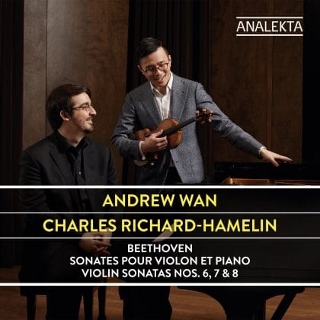BEETHOVEN’S VIOLIN SONATAS, OP. 30:
SONATA THING WRONG HERE
Beethoven composed his Sonatas for Violin and Piano, Op. 30 in 1801-02, completing most of the work between March and May of 1802. Dedicated to Czar Alexander I of Russia, the three sonatas — A major, C minor and G major — were developed during a traumatic period in Beethoven’s life when he was forced to admit to himself that he was losing his hearing (just four months after composing the sonatas, Beethoven disclosed in a letter that he was seriously considering suicide). Yet there’s a good deal of optimism and Haydenesque humor scattered throughout, possibly because the Sonatas were written while the composer had moved to a village in the Vienna Woods as a possible curative for his increasing tinnitus.
Regardless of whatever he was channeling during this particularly prolific period, the Sonatas stand at the threshold of a new creative language, the dynamic and dramatic musical speech that characterizes the creations of his so-called “second period.” One of the keys that Beethoven used to unlock this revolutionary stylistic advance was the complete permeation of melody and accompaniment, the shaping of all the lines of a musical passage and even an entire movement from a small set of thematic fragments.
Since Beethoven was dealing with feelings of both self-pity and hopefulness, the first two — although neighbors — are worlds apart in spirit. In Op. 30 No. 1 the energy is controlled: it may be Classicism rejuvenated and extended, but it’s still fundamentally Classical — almost methodical but with some striking features. No. 2 is the dog that wants out of the cage, one moment Romantic, the next discharging ferocious wit. On their new album — the first of three that will contain all ten of Beethoven’s complete Violin Sonatas – Andrew Wan (violin) and Charles Richard-Hamelin (piano) do a terrific job of discerning the two styles.
No. 1 is stretched and brawny, but also supple and affectionate; they wisely avoid fireworks to beef up the traditional sound. Yet the exciting players really have an adventure in the wilderness of the C minor Sonata, savoring the urge one moment, the surprising friskiness the next, but constantly with a steady sagacity of the longer line. The young Canadian musicians play with boundless robustness in the Allegro con brio and the unpredictable Finale. The tiniest moments of restraint in the Adagio cantabile and the Scherzo simply add to the drama as they push ahead. And I do mean “they” — this is a very even chamber duo, not star seeking the limelight plus accompanist, and the recording on Analekta reproduces it well. Even the fillers — the Rondo and German Dances — are entertaining, partly I suspect because their delight is so sonorously shared. Even more, the work’s sense of rawness and grief is highlighted by startlingly emotive performances.
Number 3 — the Violin Sonata No. 8 in G major, Op. 30 No. 3 — gets the most intense treatment. The result is a good-natured perilousness, a great combination of decorum and speed, the enunciations polished to a point, the phrasing proficiently polished.
These three pieces are nothing short of exhausting if played live in concert, and I’ve seen that affect the energy of the Op. 30, so thank goodness the boys took to the studio for this, their first studio collaboration. (They actually did perform these pieces live already, so that may explain how seamless they are as a team on the recording.) It’s with gratitude that I recommend this interpretation of these pieces from Beethoven’s heroic middle period.
Beethoven: Violin Sonatas, Op.30
Andrew Wan, violin, and Charles Richard-Hamelin, piano
Analekta | 69:20
released on October 5, 2018
available on Amazon and iTunes



